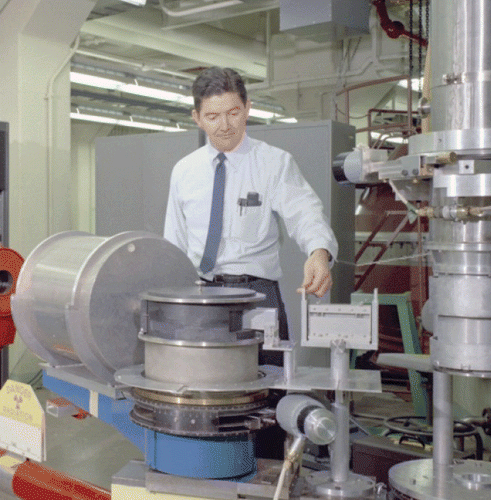Introduction
Our dear friend and colleague Hal Smith passed away on October 9, 2012 in Oak Ridge, Tennessee, USA. After graduation from Lafayette High School in 1944, Hal joined the US Navy to become an air crewman Petty Officer 2nd class in World War II. Under the G. I. Bill he graduated with honors in physics from the University of Louisiana-Lafayette in 1949. He married his wife, Marion (Sal) Batty in 1950 in New Orleans and graduated from Tulane University (M.S. Physics) in 1951. He worked as an x-ray crystallographer in the Ames Laboratory at Iowa State University at Ames, Iowa from 1951 to 1954 where he pursued his Ph.D. in physics from 1954 to 1957. In that year he joined Bill Busing and Henry Levy in the neutron diffraction group at Oak Ridge National Laboratory (ORNL)'s Chemistry Division to study the structure of crystals at the Graphite Reactor and the Oak Ridge Research Reactor (ORR). In 1962 he joined Mike Wilkinson to setup a new inelastic neutron scattering program at ORNL's Solid State Division to investigate the dynamical properties of atoms in solids. This group was later expanded to include Robert Nicklow, Herbert Mook and Nobuyoshi Wakabayashi. The group constructed the first triple-axis spectrometer in the US at the ORR, which was based on an instrument developed at the Chalk River Laboratory in Canada by Bertram Brockhouse, and then similar instruments at the High Flux Isotope Reactor.
The materials that Hal studied included metals such as Cu, Au, Ti, Co, Tc and rare-earth metals; ionic materials including LiF, AgCl and TiO2, superconductors like alpha-U, and semiconductors like MoS2 and graphite to name only a few. His work also included studies of alloys, thereby elucidating the influence of disorder on the dynamical properties of crystals in which the theoretically predicted localized and resonant modes of vibration were observed, and studies of phase transitions in alpha-U and alkali metals Na and Li. His work added significantly to the understanding of the nature of interatomic interactions in solids. At Oak Ridge Hal developed the x-ray and neutron sensitive Polaroid camera, which was used worldwide for many years.
Over the years he held many posts; he was a guest scientist at AERE, Harwell, England from 1961 to 1962 and at the Institute Laue-Langevin in Grenoble, France in the 1980's. He was a member, then Chairman of the Neutron Diffraction Commission of the International Union of Crystallography. He was the ORNL correspondent for Neutron News from 1990 to 1994. Hal retired from ORNL in September 1993.
Hal had a distinguished scientific career; he was author or co-author of numerous scientific papers, book chapters, and review articles. He published in the areas of physics, materials science, crystallography and metallurgy. After retirement he formed a small consulting company, Neutronics of Oak Ridge, where he purchased and assembled parts for neutron-sensitive CCD cameras for various reactor groups in this country and Canada.
Hal will be remembered by his friends and colleagues as a fine scientist, a wonderful human being and a true gentleman. In his private life, he was absorbed with conservation efforts of wild lands in Tennessee, photography, and hiking. He is survived by his wife of 62 years, Marion (Sal) Smith, daughter Lorie Janet James and her husband Lyle James of Salt Lake City, Utah, a son, Brian Alan Smith and his wife, Sandra Salgado of Austin, Texas, and two grandchildren, Daniel Enrique and Clara Patricia, also of Austin. A daughter, Lynette Elaine Smith preceded him in death in 1977.
